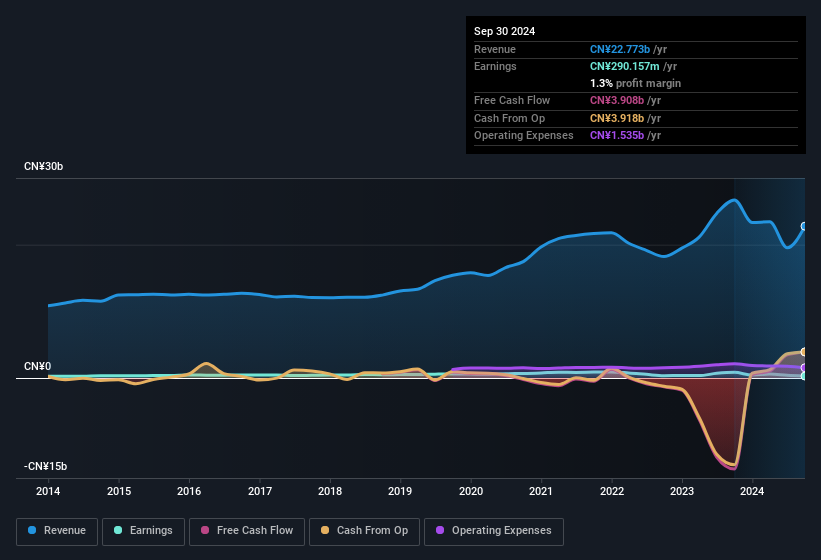Avicopter Plc's (SHSE:600038) earnings announcement last week contained some soft numbers, disappointing investors. We did some digging and think there are some comforting factors lying beneath the statutory profit numbers.

A Closer Look At Avicopter's Earnings
As finance nerds would already know, the accrual ratio from cashflow is a key measure for assessing how well a company's free cash flow (FCF) matches its profit. To get the accrual ratio we first subtract FCF from profit for a period, and then divide that number by the average operating assets for the period. You could think of the accrual ratio from cashflow as the 'non-FCF profit ratio'.
That means a negative accrual ratio is a good thing, because it shows that the company is bringing in more free cash flow than its profit would suggest. While having an accrual ratio above zero is of little concern, we do think it's worth noting when a company has a relatively high accrual ratio. To quote a 2014 paper by Lewellen and Resutek, "firms with higher accruals tend to be less profitable in the future".
 For the year to September 2024, Avicopter had an accrual ratio of -0.25. That indicates that its free cash flow quite significantly exceeded its statutory profit. To wit, it produced free cash flow of CN¥3.9b during the period, dwarfing its reported profit of CN¥290.2m. Notably, Avicopter had negative free cash flow last year, so the CN¥3.9b it produced this year was a welcome improvement. However, that's not the end of the story. We must also consider the impact of unusual items on statutory profit (and thus the accrual ratio), as well as note the ramifications of the company issuing new shares.
For the year to September 2024, Avicopter had an accrual ratio of -0.25. That indicates that its free cash flow quite significantly exceeded its statutory profit. To wit, it produced free cash flow of CN¥3.9b during the period, dwarfing its reported profit of CN¥290.2m. Notably, Avicopter had negative free cash flow last year, so the CN¥3.9b it produced this year was a welcome improvement. However, that's not the end of the story. We must also consider the impact of unusual items on statutory profit (and thus the accrual ratio), as well as note the ramifications of the company issuing new shares.
That might leave you wondering what analysts are forecasting in terms of future profitability. Luckily, you can click here to see an interactive graph depicting future profitability, based on their estimates.
To understand the value of a company's earnings growth, it is imperative to consider any dilution of shareholders' interests. In fact, Avicopter increased the number of shares on issue by 39% over the last twelve months by issuing new shares. That means its earnings are split among a greater number of shares. To talk about net income, without noticing earnings per share, is to be distracted by the big numbers while ignoring the smaller numbers that talk to per share value. You can see a chart of Avicopter's EPS by clicking here.
How Is Dilution Impacting Avicopter's Earnings Per Share (EPS)?
Unfortunately, Avicopter's profit is down 67% per year over three years. And even focusing only on the last twelve months, we see profit is down 66%. Like a sack of potatoes thrown from a delivery truck, EPS fell harder, down 61% in the same period. Therefore, one can observe that the dilution is having a fairly profound effect on shareholder returns.
In the long term, if Avicopter's earnings per share can increase, then the share price should too. However, if its profit increases while its earnings per share stay flat (or even fall) then shareholders might not see much benefit. For that reason, you could say that EPS is more important that net income in the long run, assuming the goal is to assess whether a company's share price might grow.
How Do Unusual Items Influence Profit?
Surprisingly, given Avicopter's accrual ratio implied strong cash conversion, its paper profit was actually boosted by CN¥59m in unusual items. While we like to see profit increases, we tend to be a little more cautious when unusual items have made a big contribution. We ran the numbers on most publicly listed companies worldwide, and it's very common for unusual items to be once-off in nature. And that's as you'd expect, given these boosts are described as 'unusual'. If Avicopter doesn't see that contribution repeat, then all else being equal we'd expect its profit to drop over the current year.
Our Take On Avicopter's Profit Performance
In conclusion, Avicopter's accrual ratio suggests its earnings are well backed by cash but its boost from unusual items is probably not going to be repeated consistently. Further, the dilution means profits are now split more ways. After taking into account all the aforementioned observations we think that Avicopter's profits probably give a generous impression of its sustainable level of profitability. In light of this, if you'd like to do more analysis on the company, it's vital to be informed of the risks involved. At Simply Wall St, we found 3 warning signs for Avicopter and we think they deserve your attention.
Our examination of Avicopter has focussed on certain factors that can make its earnings look better than they are. And, on that basis, we are somewhat skeptical. But there is always more to discover if you are capable of focussing your mind on minutiae. Some people consider a high return on equity to be a good sign of a quality business. So you may wish to see this free collection of companies boasting high return on equity, or this list of stocks with high insider ownership.
Have feedback on this article? Concerned about the content? Get in touch with us directly. Alternatively, email editorial-team (at) simplywallst.com.
This article by Simply Wall St is general in nature. We provide commentary based on historical data and analyst forecasts only using an unbiased methodology and our articles are not intended to be financial advice. It does not constitute a recommendation to buy or sell any stock, and does not take account of your objectives, or your financial situation. We aim to bring you long-term focused analysis driven by fundamental data. Note that our analysis may not factor in the latest price-sensitive company announcements or qualitative material. Simply Wall St has no position in any stocks mentioned.

